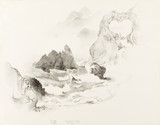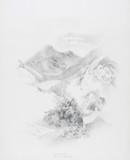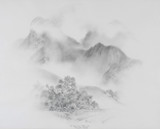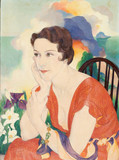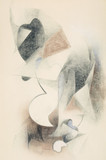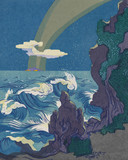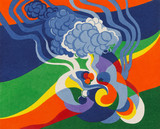Cofounder of synchromism and one of the most influential artists in Southern California, Stanton MacdonaldWright was raised in Santa Monica and studied art as a teenager with Joseph Greenbaum (1864 -1940) and at the Art Students League of Los Angeles with Warren T. Hedges (1883-1910). In 1907 he went to Paris, where he enrolled at the Sorbonne, Académie Colarossi, Ecole des Beaux-Arts, and Académie Julian. He exhibited publicly for the first time in 1910 at the Salon d’Automne. In 1911 he attended classes conducted by Ernest Percyval Tudor-Hart (1873-1954) in which he learned much about color theory and met MORGAN RUSSELL. Together they formulated the theory of synchromism, asserting that color was an abstract medium capable of conveying light, space, and form. The two first exhibited together as synchromists in June 1913 at the Neue Kunstsalon in Munich and again a few months later in Paris at the Bernheim-Jeune gallery; they showed the following year in New York at Carroll Galleries. MacdonaldWright exhibited in the landmark Forum Exhibition of Modern American Painters of 1916 and was given a solo exhibition by Alfred Stieglitz (1864-1946) at his "291" gallery in March 1917. From 1916 to 1919 Macdonald-Wright worked in New York, painting synchromies that were based on human figures, still-life paintings, and landscapes.
Macdonald-Wright returned to Southern California in 1919 and maintained a residence in the Los Angeles area for the rest of his life, becoming the area’s dean of modernist art and, along with LORSER FEITELSON (after his arrival in 1927), influencing the next generation. He directed the Art Students League of Los Angeles for most of the twenties, beginning in 1922. During that decade he experimented with color film, an extension of his interest in colored light. He continued to paint figures and landscapes but in a less cubist, fragmented manner. During the depression Macdonald-Wright served as director of the Southern California Federal Art Project. He received mural commissions, the most extensive for the Santa Monica Public Library (National Museum of American Art, Smithsonian Institution, Washington, D.C.); he also invented "petrachrome" a modification of terrazzo for permanent murals.
In his search for a new means of artistic freedom he became increasingly fascinated with the Orient, visiting Japan in 1937 and later, in 1952-53, dividing his time between Kyoto and Santa Monica. Zen philosophy and oriental art offered him the means to create a more transcendent vision. By the 1930s Macdonald-Wright’s subjects were often oriental sages and Buddhist myths and legends. He taught oriental philosophy and art history at the University of California, Los Angeles, for a decade beginning in 1942. His paintings of the mid-1940s are basically syntheticcubist compositions; he returned briefly to synchromism in the 1950s. After suffering a severe heart attack he devoted his time to writing on art and poetry. In 1965-66 he illustrated haiku poems with wood-block prints.
BIBLIOGRAPHY
Willard Huntington Wright, "Synchromism," in Modern Painting: Its Tendency and Meaning (New York: Dodd, Mead, 1915), pp. 277-304 § Washington, D.C., Smithsonian Institution, National Collection of Fine Arts, The Art of Stanton Macdonald-Wright, exh. cat., 1967, published by Smithsonian Institution Press, with introduction by David W. Scott, excerpts and treatise on color by the artist, bibliography § Los Angeles, University of California, Art Galleries, Stanton Macdonald-Wright: A Retrospective Exhibition, 1911-1970, exh. cat., 1970, with interview with the artist by Frederick Wight § American Art Review 1 (January-February 1974): 48-68, issue devoted to the artist, with essays by David W. Scott and Henry Clausen and interview with the artist by John Alan Walker § New York, Whitney Museum of American Art, and others, Synchromism and American Color Abstraction, 1910-1925, exh. cat., 1978 (copublished with George Braziller, New York), by Gail Levin, with reprints of synchromist catalogues, biographical notes, bibliography.
